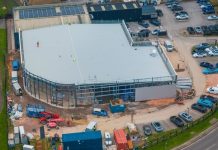The next generation of office buildings will draw employees back to the workplace, a new report from architect and design experts, Gensler, suggests. In an interesting U-turn, an increased number of employees are set to be drawn back to the office, as the importance and power of face-to-face interaction grows, and office design increasingly caters towards this.
This year’s 2018 Design Forecast report, “Shaping the Future of Cities”, created by the Gensler Research Institute explores over 200 of the latest trends that are changing cities across the world. The overarching prediction is that design will “put people back at the center” and become the driving force behind resilient, livable cities. Buildings that react and respond to the people within it will be critical to the workplace experience, harnessing data to interpret internal workplace data and make intelligent adaptations. Other key trends include:
The impact of cities on workplace design
Cities are nurturing a new mix of businesses and people, and growing at an unprecedented rate, contributing more than 80% of global GDP. With more companies choosing to locate to cities, the workplace design has been a core focus to attract talent – developing a synergic relationship with the local community has become essential to communicate and infuse the workplace with the urban core to engage employees, clients, and the community at large.
Importance of individual experience
With workplace strategies now following the ‘one size does not fit all’ mindset, multipurpose buildings will become default, making single-use spaces obsolete. In a rapidly changing environment, designers will be required to rethink and reinvent how people experience every aspect of their lives and spaces that they live in.
Data from the Gensler Experience IndexSM uncovered a direct connection between the quality of design and a positive emotional response from people and found the best experiences anticipate people’s needs, tap into their emotions, and engage the senses.
The rise of ‘smart cities’
Gensler leads some of the world’s largest city developments, with 48 offices globally and 3,500+ clients in every industry imaginable – their work quite literally shapes how cities look, and how people interact in them. Gensler sees “smart cities” in terms of their adaptability and resilience. As engines of innovation, their leaders are in the vanguard of climate action “because they depend on it” for survival and growth. And wellness is the new measure of livability. “Health has become a major factor in urban and community planning, as research and public awareness about the link between them grows,” the report states.
Duncan Swinhoe, Regional Managing Principal, Europe from Gensler says, “Regardless of technological advances or political and economic uncertainties, design must factor in human needs and social interactions to be effective. Mobility will remain an important part of work, but the value of face-to-face remains undisputed. Prioritising experience is no longer an option, organisations must invest in the individual, diversify work spaces and reinforce a shared culture to deliver excellence in a differentiated experience.’’




















